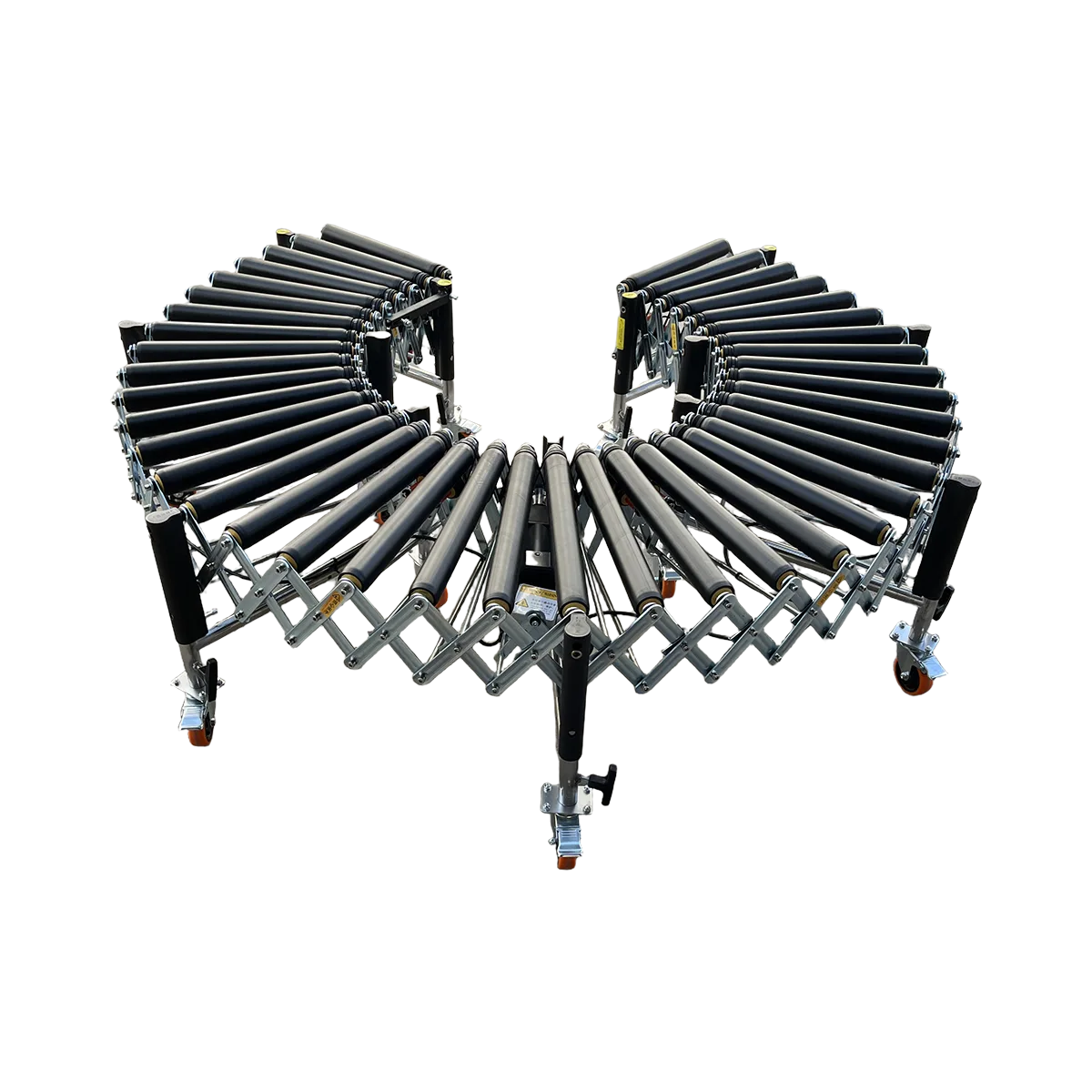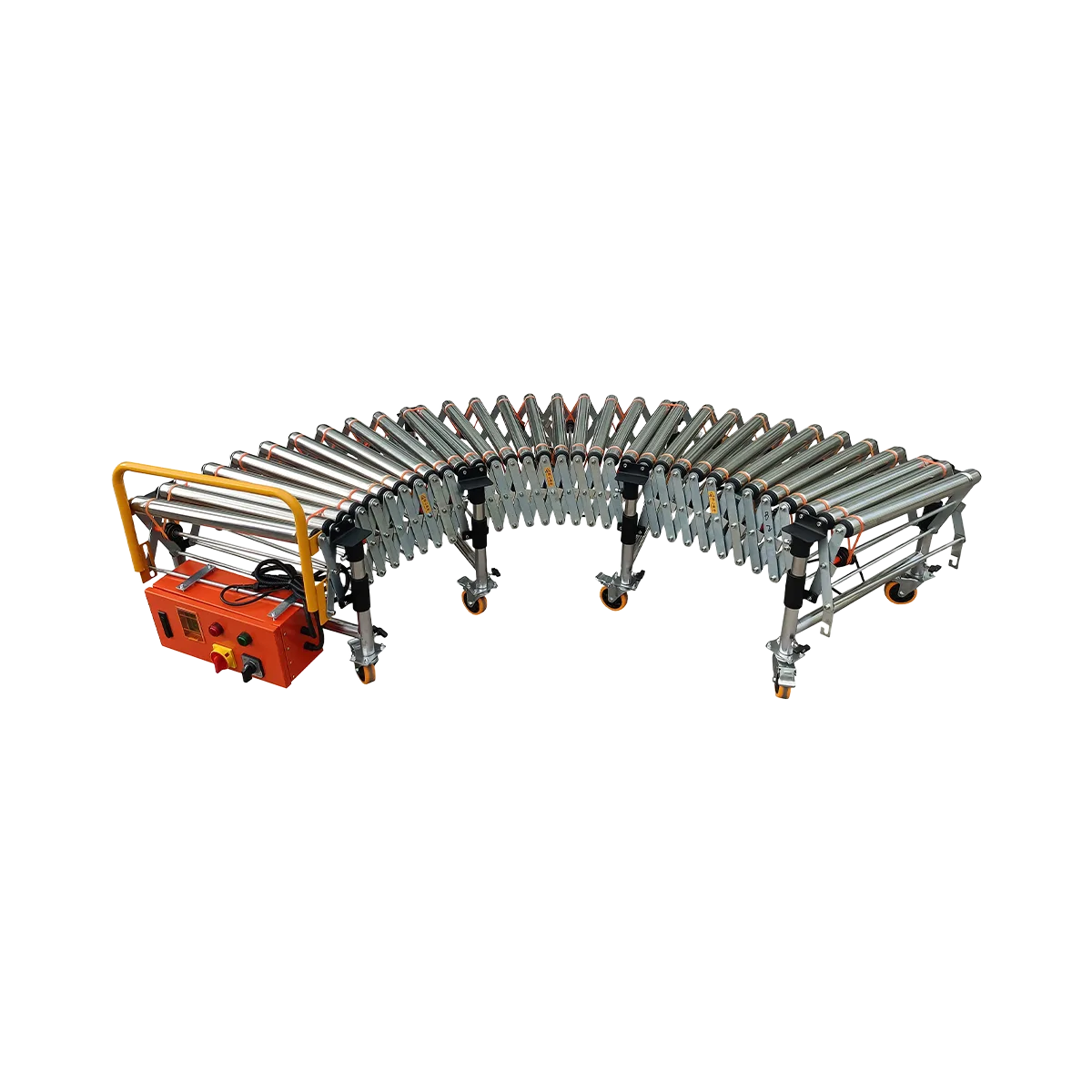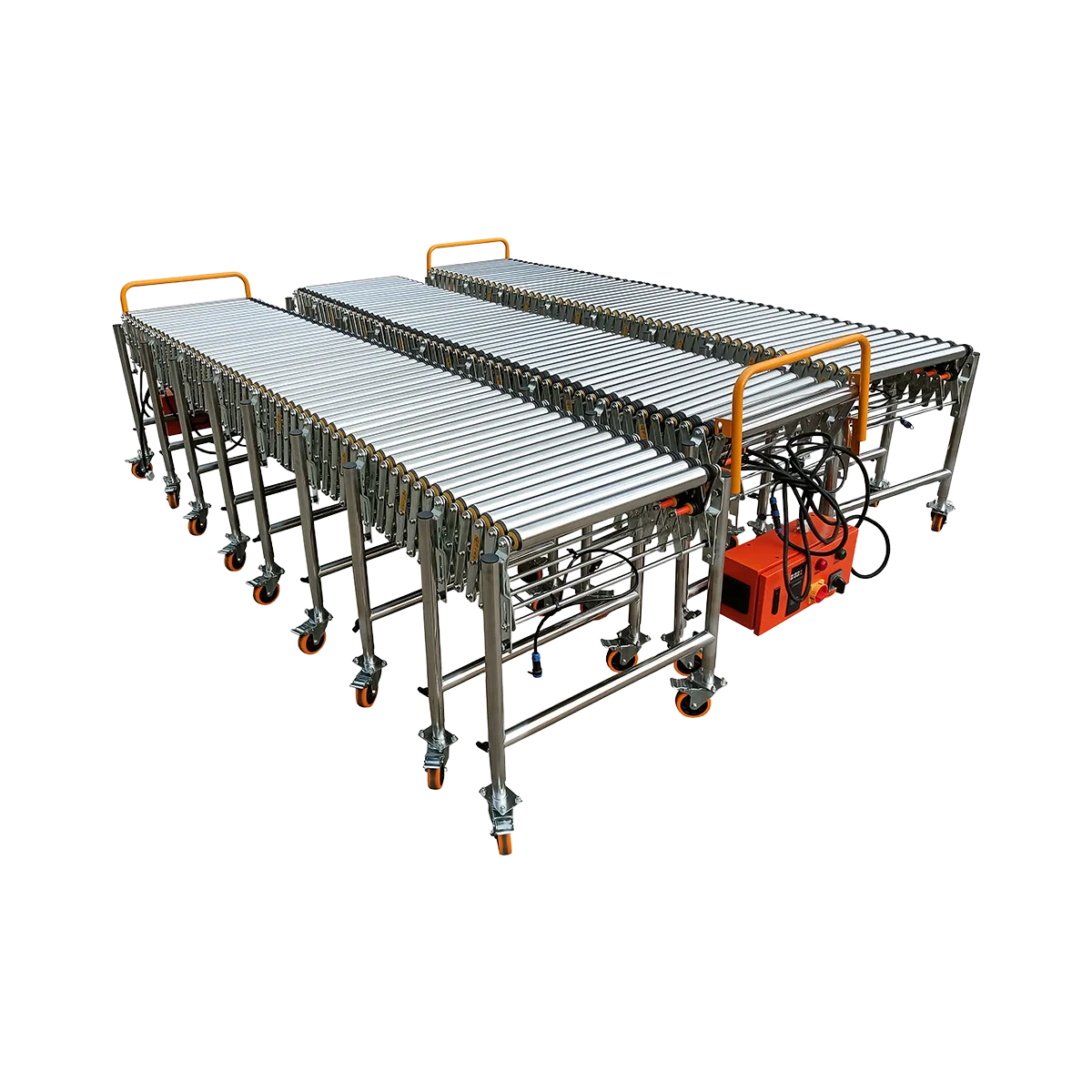Optimizing Sporting Goods Distribution with Flexible Conveyors
Discover how a sports equipment conveyor system can streamline your athletic gear logistics. Flexible conveyor solutions for all shapes and sizes of sporting goods.
Related Products
-
Powered Rubber Roller Conveyor – Multi-wedge Belt Driven – 1100 mm/SectionCollapsed Length
560 mm
Extended Length1100 mm
Load Capacity120 kg/m
Applicable GoodsFlat-bottomed Goods
Bagged Goods
-
Powered Roller Conveyor – O-shaped Belt Driven – 1500 mm/SectionCollapsed Length
525 mm
Extended Length1500 mm
Load Capacity80 kg/m
Applicable GoodsFlat-bottomed Goods
-
Powered Roller Conveyor – Multi-wedge Belt Driven – 2000 mm/SectionCollapsed Length
700 mm
Extended Length2000 mm
Load Capacity100 kg/m
Applicable GoodsFlat-bottomed Goods
-
Powered Roller Conveyor – Multi-wedge Belt Driven – 3000 mm/SectionCollapsed Length
1050 mm
Extended Length3000 mm
Load Capacity80 kg/m
Applicable GoodsFlat-bottomed Goods
The sporting goods industry presents unique distribution challenges due to the remarkable diversity of products that must be handled efficiently. From lightweight tennis balls to bulky exercise equipment, implementing an effective sports equipment conveyor system requires thoughtful planning and flexible solutions. Distribution centers handling athletic gear must balance the need for gentle handling of delicate items with the robust capabilities required for heavier equipment, all while maintaining throughput during seasonal peaks and managing the wide variety of product dimensions.
The Variety Challenge
Sports equipment distribution centers face considerable challenges due to the extreme variation in product dimensions, weights, and handling requirements. Creating a flexible loading system that can accommodate this diversity is essential for operational efficiency.
Long Items (Golf Clubs, Hockey Sticks)
Long, narrow sporting goods present particular handling challenges:
- Length considerations: Items like golf clubs, fishing rods, and hockey sticks can extend 1-2 meters in length
- Protection requirements: Many long items have delicate components that require careful handling
- Alignment issues: Long items tend to shift and misalign during transportation
- Varied weights: Despite similar dimensions, weights can range from ultralight carbon fiber tennis rackets to substantial aluminum baseball bats
Efficient handling of these items requires conveyor systems with:
- Adequate width to prevent items from hanging over edges
- Smooth surfaces to prevent scratching or damage
- Sufficient roller spacing to maintain stability throughout the conveyor path
- Side guards to prevent items from sliding off during transport
Boxed Items (Weights, Machines)
Boxed sporting goods present different challenges for distribution systems:
- Variable weight distribution: From lightweight boxing gloves to heavy weight sets
- Dimensional inconsistency: Boxes ranging from small accessory packaging to large home gym equipment
- Stability concerns: Top-heavy boxes can tip during transportation
- Durability requirements: Heavier items require robust conveyor components
Handling these items effectively requires:
- Higher load capacity conveyor sections
- Wider conveyor beds for larger packages
- Powered systems for consistent movement regardless of weight
- Adjustable speeds to accommodate varying weights safely
| Item Type | Typical Weight Range | Recommended Conveyor Type | Special Considerations |
|---|---|---|---|
| Long items (clubs, sticks) | 0.5-5 kg | 800mm Powered Roller | Side guards, consistent speed |
| Medium boxes (shoes, apparel) | 0.5-10 kg | 600mm Powered or Gravity Roller | Balance between space and capacity |
| Heavy boxes (weights, machines) | 10-100+ kg | 800mm Powered Roller with multi-wedge belt | Higher load capacity, slower speeds |
| Odd-shaped items (balls, helmets) | 0.2-5 kg | Skate Wheel or Rubber Roller | Prevent rolling or sliding |
Creating a Versatile System
Designing an athletic gear logistics system that can efficiently handle the full spectrum of sporting goods requires strategic selection and arrangement of conveyor components.
Using 800mm Powered Roller Sections for Stability
The foundation of a versatile sports equipment handling system often begins with 800mm powered roller conveyor sections:
- Superior width advantage: The 800mm width provides ample surface area for both long items and wide boxes
- Enhanced stability: Wider conveyor beds reduce the risk of items tipping or falling during transport
- Multi-wedge belt drive options: For heavier items, multi-wedge belt driven options (2000mm sections) provide up to 100 kg/m capacity
- O-type belt driven alternatives: For lighter loads, O-type belt driven sections (1500mm) offer economical solutions with 80 kg/m capacity
- Extended sections available: For long straightaways, 3000mm sections reduce the number of joints and transitions
Implementation considerations:
- For handling particularly heavy fitness equipment (60+ kg), prioritize 2000mm multi-wedge belt driven sections
- For mixed merchandise with medium weights, 3000mm sections provide economical transport for items under 60 kg
- For sections requiring frequent reconfiguration, shorter 1500mm sections offer greater flexibility
Adding Curved Sections for Efficient Space Use
Strategic use of curved conveyor sections allows for more efficient use of warehouse space while maintaining smooth product flow:
- Space optimization: Curved sections enable compact “U” or “L” shaped layouts that maximize available floor space
- Workflow improvement: Properly designed curves can direct products to specific processing areas based on type
- Reduced manual handling: Continuous conveyor paths minimize the need for manual transfers between straight sections
- Seasonal adaptability: Modular curved sections can be rearranged to accommodate changing product flows
When implementing curved sections for sporting goods:
- Ensure adequate width (800mm recommended) to prevent long items from overhanging
- Consider slightly increased incline on gravity-powered curves to maintain momentum
- Add side guards at curves to prevent long items from shifting during direction changes
- Position workers at strategic curve points for quality inspection during transport
Season-Ready Solutions
Sporting goods distribution faces significant seasonal fluctuations, with demand shifting dramatically throughout the year. A truly effective equipment distribution system must adapt to these predictable yet challenging variations.
Quick Reconfiguration for Seasonal Changes
The ability to rapidly reconfigure your conveyor system for seasonal inventory shifts provides crucial operational flexibility:
- Modular design benefits: Select conveyor systems with standardized connection points that allow for quick reconfiguration
- Winter to summer transitions: Efficiently switch from handling bulky winter sports equipment to lightweight summer gear
- Capacity adjustments: Add or remove powered sections as throughput requirements change with seasonal demand
- Zone repurposing: Quickly transform receiving areas to shipping zones during peak outbound periods
Implementation strategies:
- Use wheeled support legs with locking mechanisms for easy repositioning
- Maintain consistent heights between different conveyor types for seamless transitions
- Document successful seasonal layouts for quick reference when reconfiguring
- Train multiple team members on reconfiguration procedures to ensure operational continuity
Easy Storage During Off-Peak Periods
The collapsible nature of quality conveyor systems allows for efficient storage during slower periods:
- Space recovery: Telescoping conveyor sections can collapse to approximately 1/3 of their extended length
- Skate wheel advantages: Gravity skate wheel conveyors offer impressive 1:5 collapsibility (from 2100mm to 420mm)
- Vertical storage: Many systems can be stored vertically against walls when not in use
- Protection benefits: Storing unused sections prevents damage and extends equipment lifespan
Storage optimization approaches:
- Create dedicated storage areas with wall-mounted support brackets
- Label each section clearly before disassembly to simplify future reconfiguration
- Use protective covers for conveyor sections in long-term storage
- Implement regular maintenance checks during storage periods
For facilities handling highly seasonal sporting goods like ski equipment or summer water sports gear, consider:
- Maintaining a core permanent conveyor system for year-round items
- Supplementing with modular sections that can be added during peak seasons
- Creating standard configuration templates for quick seasonal transitions
- Implementing gravity roller conveyor sections for low-volume periods to reduce energy costs
Conclusion: Handle Any Sport’s Logistics Needs with Confidence
Implementing a well-designed warehouse automation sports solution with flexible conveyors enables distribution centers to handle the full spectrum of sporting goods with confidence and efficiency. By strategically combining 800mm powered roller sections with appropriate curved components and maintaining reconfiguration capabilities, facilities can optimize operations for both everyday efficiency and seasonal peak performance.
The key to success lies in embracing modular flexibility rather than rigid permanence. Today’s sporting goods market demands systems that can quickly adapt to changing product mixes, seasonal shifts, and evolving consumer preferences. By implementing solutions that specifically address the unique challenges of long items, heavy boxes, and seasonal fluctuations, distribution centers can maintain competitive advantage through operational excellence.
With the right conveyor system in place, sporting goods distribution facilities can minimize manual handling, reduce product damage, increase throughput capacity, and ultimately deliver better customer experiences through improved shipping accuracy and speed. As the sporting goods industry continues to evolve with new products and changing demand patterns, those with adaptable material handling systems will be best positioned to thrive.
Frequently Asked Questions
What conveyor width is best for handling a mix of sporting goods?
The 800mm width is generally optimal for mixed sporting goods distribution, providing sufficient space for both long items like golf clubs and wider boxes containing exercise equipment, while still maintaining efficient use of warehouse space.
How can our conveyor system handle both lightweight tennis rackets and heavy weight sets?
Implement a mixed system with multi-wedge belt driven powered roller sections (2000mm) handling zones for heavy items like weights (100kg/m capacity), while using standard powered or gravity sections for lighter equipment, ensuring smooth transitions between zones.
What’s the most efficient way to handle seasonal transitions like winter to summer sports?
Use modular conveyor sections with wheeled supports and quick-connect fittings that allow for rapid reconfiguration. Document successful seasonal layouts, maintain standardized heights between sections, and implement regular training for reconfiguration procedures.
Can flexible conveyors handle oddly-shaped items like basketballs and helmets?
Yes, powered rubber roller conveyors with PVC-coated rollers provide excellent grip for odd-shaped items, preventing rolling and sliding. For smaller odd-shaped items, skate wheel conveyors with closely spaced wheels offer superior control.
What maintenance is required for conveyor systems handling sporting goods?
Regular maintenance includes checking drive belts for proper tension, inspecting rollers for free rotation, lubricating bearings quarterly, cleaning surfaces to remove debris, and verifying all connecting hardware remains tight. Powered sections require additional motor and electrical system checks.
Table of Contents
Recent Posts
Optimize hardware store logistics with the right building supply conveyor systems. Our guide to tool distribution systems enhances retail warehouse automation for efficient operations.
Optimize your medical supply logistics with efficient gravity conveyor systems. Learn how to safely handle healthcare products while improving your hospital supply chain operations.
Optimize battery warehouse conveyor systems for UPS loading and safe battery transport. Our guide to efficient power cell logistics solutions ensures secure battery box handling.




